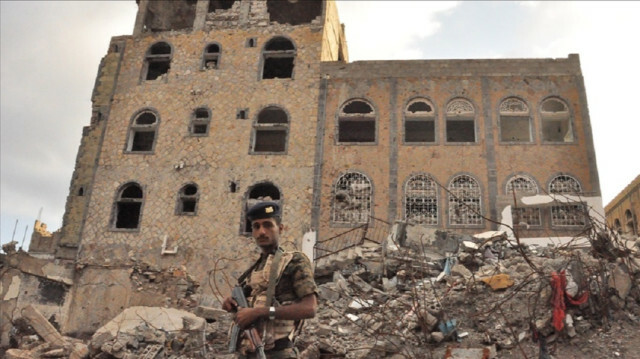
UAE has consolidated its military presence in Yemen’s southern regions, including Perim Island
Latest reports about the construction of an Emirati airbase on Yemen’s Perim Island have raised concerns about the country’s sovereignty and security of international naval trade routes.
Satellite images from Planet Labs Inc. obtained by the Associated Press, showed the construction site of an airbase on Perim Island, known also as Mayun Island, involving 1.85-kilometer (6,070-foot) runway and three hangars.
Although the United Arab Emirates (UAE) has announced in June 2019 a partial withdrawal of its troops from the Saudi-led coalition battling Yemen’s Houthi rebels, Chris Murphy, a US Senator and a Democrat from Connecticut, tweeted that the base is “a reminder that the UAE is not actually out of Yemen”.
“Yemen's national security is under unprecedented danger and it is time to stop this absurdity,” Dashela told Anadolu Agency. “The base UAE is building on Mayun Island must be destroyed and its forces must be expelled,” he said.
In March 2021, local media reported an attempt to create an airbase with a 10,000 ft (3,000 m) runway in the north of the island in 2016. The project, however, was abandoned in 2017 with some constructions and the runway outline visible.
- Blackmailing
An official source from the Saudi-led coalition described reports of the UAE military presence on Mayun and Socotra as “not true”, and defined its current efforts in Yemen as “compatible with the coalition forces in defending Marib from Houthi militias' air attacks,” according to a statement by the official Saudi news agency SPA.
The statement said the construction on Mayun Island is under the control of the Saudi-led coalition and will enable the Yemeni government and coalition forces to confront Houthi rebels, secure maritime navigation, and support the West Coast forces.
Abdulsalam Muhammed, chairman of Abaad Studies and Research Center, said the coalition’s confirmation of the UAE presence on the island “collides with the UAE’s earlier announcement of its exit from Yemen”.
This means that “Saudi Arabia is coordinating with the UAE in all its activities in the south of Yemen,” Muhammed told Anadolu Agency.
Muhammed continued, “Referring to Marib in the coalition’s statement indicates linking the violation of Yemen’s sovereignty to the justification for defending Marib, which is an act of blackmail”.
“They condition protecting Marib in exchange for occupying the islands of Mayun and Socotra, controlling Mocha in exchange for Taiz, and keeping the legitimate government forces in Shabwa in return for handing over Aden to Southern Transitional Council (STC) forces,” he added.
- Saudi message
Dashela echoes a similar belief, saying the coalition’s statement conveyed a clear message to the Yemeni government to “either remain silent on what is happening in Socotra and Mayun islands, or they will stop their air support and let the Houthis storm Marib.”
In March, the Saudi-led coalition withdrew its Patriot defense system, which was protecting Marib from Houthi missiles. The move enabled the Iran-aligned rebels to take advantage of the situation to start an ongoing offensive campaign on Marib since February.
Yemen has been beset by violence and chaos since 2014, when Houthi rebels overran much of the country, including the capital, Sanaa. The crisis escalated in 2015 when a Saudi-led coalition, of which the UAE is a member, launched a devastating air campaign aimed at rolling back Houthi territorial gains.
According to the UN Office for the Coordination of Humanitarian Affairs, the conflict has claimed more than 233,000 lives.
- Red Sea
Over the past five years, the UAE has pursued an ambitious strategic agenda in the Red Sea, building military installations and securing control of the southern coasts of Yemen along the Arabian Sea in the Bab al-Mandab Strait and Socotra Island.
Despite reducing its military footprints in Yemen in 2019, the UAE has consolidated itself in the southern regions. It has continued to finance and impart training to thousands of Yemeni fighters drafted from various groups like the Security Belt Forces, the Shabwani and Hadrami Elite Forces, Abu al-Abbas Brigade, and West Coast Forces.
Muhammed, who is also the co-writer of the newly published book “UAE’s Game in Yemen”, believes that the UAE's repeated attempts to gain control of the Yemeni coast show the “real motives for its participation in the Arab coalition and intervention in Yemen”.
“The UAE’s political and military influence in southern and western coasts of Yemen will give it superiority over regional powers competing with it over the southern Red Sea region and eastern Africa, including Turkey, Qatar, Iran and Saudi Arabia,” he said.
Analysts think that the UAE is using Yemen’s weakness to build its own military outlets in an attempt to control international naval trade lanes.
“The UAE believes that its control of the Yemeni coasts will guarantee its alliance with international powers which might assign it to play an international role in protecting global economic interests by participating in securing maritime trade and oil routes in the Red Sea,” Muhammed argues.

